


Tortoises that have flattened, bumpy and unnatural looking shells have metabolic bone disease (MBD). MBD is alarmingly common among captive raised tortoises due to poor nutrition and substandard husbandry practices. In more severe cases of MBD, the carapace may slope down towards the tail, jaws may be deformed, and limbs may be swollen. The tortoise may be lame and unable to lift itself off the ground. In advanced cases, the whole tortoise may look grossly deformed.
If you are planning to acquire a tortoise, be sure to research the proper diet and care for your species beforehand to help prevent this devastating and debilitating condition. Plenty of sunshine for UV exposure, right kind of fiber rich foods, proper amounts of nutrients (calcium, etc.), adequate water intake, sufficient exercise, and a low stress environment are all very important for tortoises' health.
In captivity, many young tortoises will pyramid, i.e., grow conical scutes or look bumpy, to some degree as they grow. Minor shell pyramiding, if the tortoise is otherwise healthy, is considered to be cosmetic only and does not affect the tortoise's life and health.
In the past, pyramiding was thought be caused by too much protein in the diet, too much food, not enough calcium, lack of sunlight or vitamin D3, not enough exercise, too dry conditions, or any combination of these.
Nowadays, many keepers believe that too dry environmental conditions during the early years of growth is propably the main contributor to shell pyramiding. Dryness leads to chronic dehydration, dries out shell keratin, and leads to rigid, deformed shells. High ambient humidity is especially important for growing tropical tortoises like the stars.
Some tortoise species are much more prone to shell pyramiding than others. Leopard and star tortoises, both Indian and Burmese, are among the easiest to pyramid species. High ambient humidity during early years of growth helps help combat this tendency to pyramid, but may not eliminate it totally.
Greek tortoises are not at all as prone to pyramiding. With proper care they will grow smooth as long as they have damp substrate areas they can dig into. These humid substrate areas (microclimates) are important for their hydration and shell growth.
1.) Indian star tortoises
Indian / Sri Lankan star tortoises (Geochelone elegans) may have smooth or bumpy, pyramided carapaces. Other than lumpiness caused by poor captive conditions, no one seems to know yet for sure why some of them have bumpier shells than others. Explanations for shell lumpiness in the Indian star range from genetics to the effects of geographical location to variations in diet.
Many believe that Sri Lankan stars, and possibly stars from north western India, tend to be more susceptible to shell coning than Indian stars from southern India. Some star tortoise breeders have described how Sri Lankan stars will often pyramid to some degree no matter how one cares for them. Even if they are raised under identical conditions as smoother growing Indian stars.
Tortoise keepers are debating if this lumpiness truly is a natural condition among star tortoises or is caused by environmental factors. However, most reptile books, new and old, describe the Indian star tortoise typically being somewhat pyramided with more or less conical scutes (scroll down to descriptions).
The conical scutes in Indian / Sri Lankan star tortoises look similar, but not identical, to diseased pyramiding (MBD). However, even this is debatable. Some people say all pyramiding in tortoises is a form of MBD, while others differentiate between "natural" pyramiding (as in stars?) and MBD. Caution though, not every pyramided Indian / Sri Lankan star is a healthy tortoise. Many have MBD due to improper care.
2.) Burmese star tortoises
Burmese star tortoises (Geochelone platynota) are also called flatback tortoises, meaning they have flat and less domed carapaces. In the wild, Burmese stars typically have smoother shells than Indian / Sri Lankan stars, but when raised in captivity, Burmese can easily develop pyramiding just like Indians. Especially, if they are kept in too dry conditions as babies.
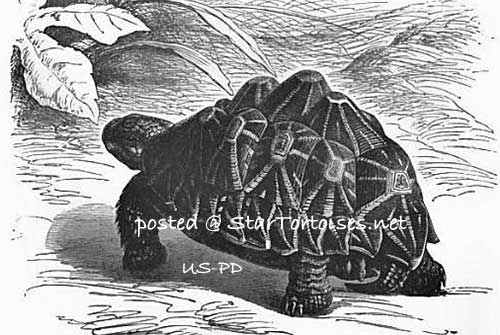
Elegant tortoise. The Royal Natural History: Reptiles, amphibians, fishes, the lowest vertebrates and their allies, Volume 5 of The Royal Natural History, Richard Lydekker, 1896. (US-PD) [now called Indian / Sri star]
![Peltastes platynotus [Geochelone platynota], Blyth 1863](./images/bs-peltastesplatynotus.jpg)
Peltastes platynotus, Blyth 1863. Proceedings of the Zoological Society of London 1870. (US-PD) [now called Geochelone platynota, Burmese star]
Africa has its own starred tortoise species. Tent tortoises (Psammobates tentorius), geometric tortoises (Psammobates geometricus), and serrated tortoises (Psammobates oculifer) have beautiful star patterned carapaces.
According to Branch (Tortoises, Terrapins & Turtles of Africa, 2008, South Africa), serrated tortoises have slightly raised carapace scutes, tent tortoises have flat or conical scutes depending on the subspecies, and geometric tortoises have raised cone like scutes. In fact, the tent tortoises were named after the conical, tent like vertebral and costal scutes. Tentorium is Latin for tent.
In photos, pyramiding in these African starred tortoises ranges from mildly raised scutes to severely conical. The appearance is very similar to that of Indian / Sri Lankan star tortoises.
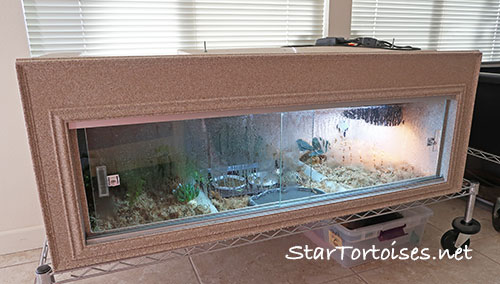
Raising Burmese and Indian / Sri Lankan star tortoise babies in high humidity vivariums, aka terrariums or closed chambers, has shown to reduce the amount of shell pyramiding in growing youngsters. Notice how food is served on a large tray (behind the shallow water dish) to prevent accidental ingestion of substrate.
To grow properly, every tortoise needs to have his basic needs met first. These include food items suitable for the species, correct and varied diet (fiber, calcium, minerals, vitamins), internal and external hydration, enough UVB exposure (ideally natural sun), large enough enclosure for exercise (preferably outdoors), and a low stress environment.
Some species of captive raised tortoises pyramid easily even when they are appropriately cared for and are not otherwise ill. Stars are among them. So far, nobody knows for sure how to totally prevent this type of pyramiding, but a couple of different approaches are being utilized by tortoise keepers to reduce the amount of pyramiding.
1.) Humid conditions
In general, high ambient humidity, warm and damp substrate areas (esp. for burrowing species), regular soaks to encourage drinking of water (internal hydration), densely planted enclosures to create more humid hiding places, and humid hides filled with moist substrates are all beneficial, especially during the first few years of life.
The most popular method for trying to lessen the amount of pyramiding in growing tropical tortoises is to raise babies in a warm, high humidity environment. Many star tortoise keepers raise their hatchlings in fully closed reptile habitats (aka vivariums, terrariums, or closed chambers) with an ambient humidity level of 80-100%. Juveniles can enjoy part of their day outdoors and then be brought in to spend the night in a warm, high humidity enclosure.
High ambient humidity of vivariums is helpful in reducing pyramiding in growing tortoises, but it's not a foolproof way to prevent it. Generally, Burmese star tortoise babies raised in warm and humid vivariums grow beautifully smooth for the first 6-12 months of their life, but by one year of age many will start to pyramid. Some more, some less. By this time, most babies live with their new owners and may start to pyramid no matter how humid they are kept.
2.) Oil...??? (very controversial)
Another approach being explored is moisturizing the top shell of young, growing tortoises with a very light application of oil. A small number of keepers have had decent success with this method, but it’s still very controversial. Some keepers promote it while others are appalled by the idea.
The goal is to retain moisture and keep the shell keratin supple enough to prevent major pyramiding. Cold pressed extra virgin coconut oil and a moisturizer by Nature Zone called Turtle & Tortoise Shell Saver are the most popular choices. Coconut oil is very greasy, but the Shell Saver is more like liquid hand lotion. It contains a mix of oils (soybean, coconut, wheat germ, avocado, castor, olive, and rosemary) along with a few other ingredients.
If any oil is used, it should be applied very SPARINGLY on the carapace (top shell) only, NOT on the skin. Tortoises use the skin of their necks and legs to absorb UVB for vitamin D3 production, and you don’t want to interfere with that. Application frequency among keepers ranges from weekly to once every few months. Many apply the oil only on the growth lines between the carapace scutes, not all over the shell.
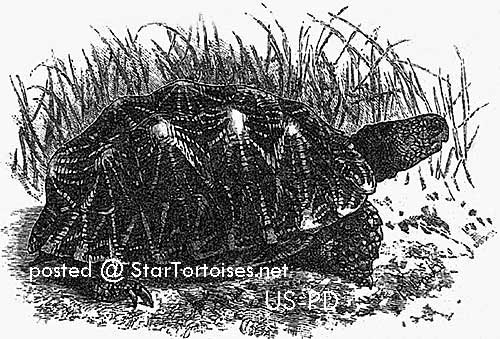
Reptilia And Batrachia: The Fauna Of British India Including Ceylon And Burma, Boulenger 1890. (US-PD) [Indian star]
1.) Burmese star shell descriptions in books
2.) Burmese star shell descriptions on the web
3.) Indian star shell descriptions in books
4.) Indian star shell descriptions on the web
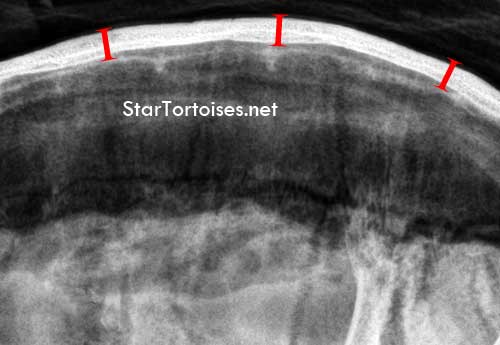
X-ray of a smooth tortoise carapace (top shell). The shape and thickness of the shell is pretty much the same all over.
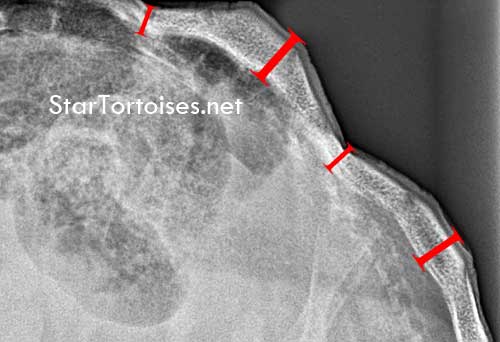
X-ray of a pyramided tortoise carapace (top shell). A lot of variation in the shape and thickness of the shell. The bone also looks more porous.